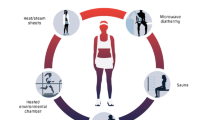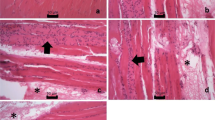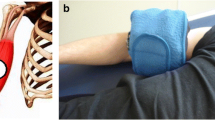Abstract
This study investigated the hypothesis that muscle damage would be attenuated in muscles subjected to passive hyperthermia 1 day prior to exercise. Fifteen male students performed 24 maximal eccentric actions of the elbow flexors with one arm; the opposite arm performed the same exercise 2–4 weeks later. The elbow flexors of one arm received a microwave diathermy treatment that increased muscle temperature to over 40°C, 16–20 h prior to the exercise. The contralateral arm acted as an untreated control. Maximal voluntary isometric contraction strength (MVC), range of motion (ROM), upper arm circumference, muscle soreness, plasma creatine kinase activity and myoglobin concentration were measured 1 day prior to exercise, immediately before and after exercise, and daily for 4 days following exercise. Changes in the criterion measures were compared between conditions (treatment vs. control) using a two-way repeated measures ANOVA with a significance level of P < 0.05. All measures changed significantly following exercise, but the treatment arm showed a significantly faster recovery of MVC, a smaller change in ROM, and less muscle soreness compared with the control arm. However, the protective effect conferred by the diathermy treatment was significantly less effective compared with that seen in the second bout performed 4–6 weeks after the initial bout by a subgroup of the subjects (n = 11) using the control arm. These results suggest that passive hyperthermia treatment 1 day prior to eccentric exercise-induced muscle damage has a prophylactic effect, but the effect is not as strong as the repeated bout effect.






Similar content being viewed by others
References
Clarkson PM, Nosaka K, Braun B (1992) Muscle function after exercise-induced muscle damage and rapid adaptation. Med Sci Sports Exerc 24:512–520
Draper DO, Knight K, Fujiwara T, Castel JC (1999) Temperature change in human muscle during and after pulsed short-wave diathermy. J Orthop Sports Phys Ther 29:13–22
Jayaraman RC, Reid RW, Foley JM, Prior BM, Dudley GA, Weingand KW, Meyer RA (2004) MRI evaluation of topical heat and static stretching as therapeutic modalities for the treatment of eccentric exercise-induced muscle damage. Eur J Appl Physiol 93:30–38
Koh TJ (2002) Do small heat shock proteins protect skeletal muscle from injury? Exer Sport Sci Rev 30:117–121
Kregel KC (2002) Heat shock proteins: modifying factors in physiological stress responses and acquired themotolerance. J Appl Physiol 92:2177–2186
McArdle A, Dillmann WH, Mestril R, Faulkner JA, Jackson MJ (2004a) Overexpression of HSP70 in mouse skeletal muscle protects against muscle damage and age-related muscle dysfunction. FASEB J 18:355–357
McArdle F, Spiers S, Aldemir H, Vasilaki A, Beaver A, Iwanejko L, McArdle A, Jackson MJ (2004b) Preconditioning of skeletal muscle against contraction-induced damage: the role of adaptations to oxidants in mice. J Physiol 561:233–244
McHugh MP (2003) Recent advances in the understanding of the repeated bout effect: the protective effect against muscle damage from a single bout of eccentric exercise. Scan J Med Sci Sports 13:88–97
Miyabara EH, Martin JL, Griffin TM, Moriscot AS, Mestril R (2005) Overexpression of inducible 70-kDa heat shock protein (HSP70) in mouse attenuates skeletal muscle damage induced by cryolesion. Am J Physiol Cell Physiol 290:C1128–C1138
Nosaka K, Sakamoto K, Newton M, Sacco P (2001) How long does the protective effect on eccentric exercise-induced muscle damage last? Med Sci Sports Exerc 33:1490–1495
Nosaka K, Sakamoto K, Newton M, Sacco P (2004) Influence of pre-exercise muscle temperature on responses to eccentric exercise. J Athletic Training 39:132–137
Nosaka K, Newton MJ, Sacco P (2005) Attenuation of protective effect against eccentric exercise-induced muscle damage. Can J Appl Physiol 30:529–542
Oishi Y, Taniguchi K, Matsumoto H, Ishihara A, Ohira Y, Roy RR (2002) Muscle type-specific responses of HSP60, HSP72, and HSC73 during recovery after elevation of muscle temperature. J Appl Physiol 92:1097–1103
Proske U, Morgan DL (2001) Muscle damage from eccentric exercise: mechanism, mechanical signs, adaptation and clinical applications. J Physiol 537:333–345
Selsby JT, Dodd SL (2005) Heat treatment reduces oxidative stress and protects muscle mass during immobilization. Am J Physiol Regul Integr Comp Physiol 289:R134–R139
Symons TB, Clasey JL, Gater DR, Yates JW (2004) Effects of deep heat as a preventative mechanism on delayed onset muscle soreness. J Strength Cond Res 18:155–161
Thompson HS, Scordilis SP, Clarkson PM, Lohrer WA (2001) A single bout of eccentric exercise increases HSP27 and HSC/HSP70 in human skeletal muscle. Acta Physiol Scand 171:187–193
Thompson HS, Clarkson PM. Scordilis SP (2002) The repeated bout effect and heat shock proteins: intramuscular HSP27 and HSP70 expression following two bouts of eccentric exercise in humans. Acta Physiol Scand 174:47–56
Thompson HS, Maynard EB, Morales ER, Scordilis SP (2003) Exercise-induced HSP27, HSP70 and MAPK responses in human skeletal muscle. Acta Physiol Scand 178:61–67
Author information
Authors and Affiliations
Corresponding author
Rights and permissions
About this article
Cite this article
Nosaka, K., Muthalib, M., Lavender, A. et al. Attenuation of muscle damage by preconditioning with muscle hyperthermia 1-day prior to eccentric exercise. Eur J Appl Physiol 99, 183–192 (2007). https://doi.org/10.1007/s00421-006-0331-5
Accepted:
Published:
Issue Date:
DOI: https://doi.org/10.1007/s00421-006-0331-5




